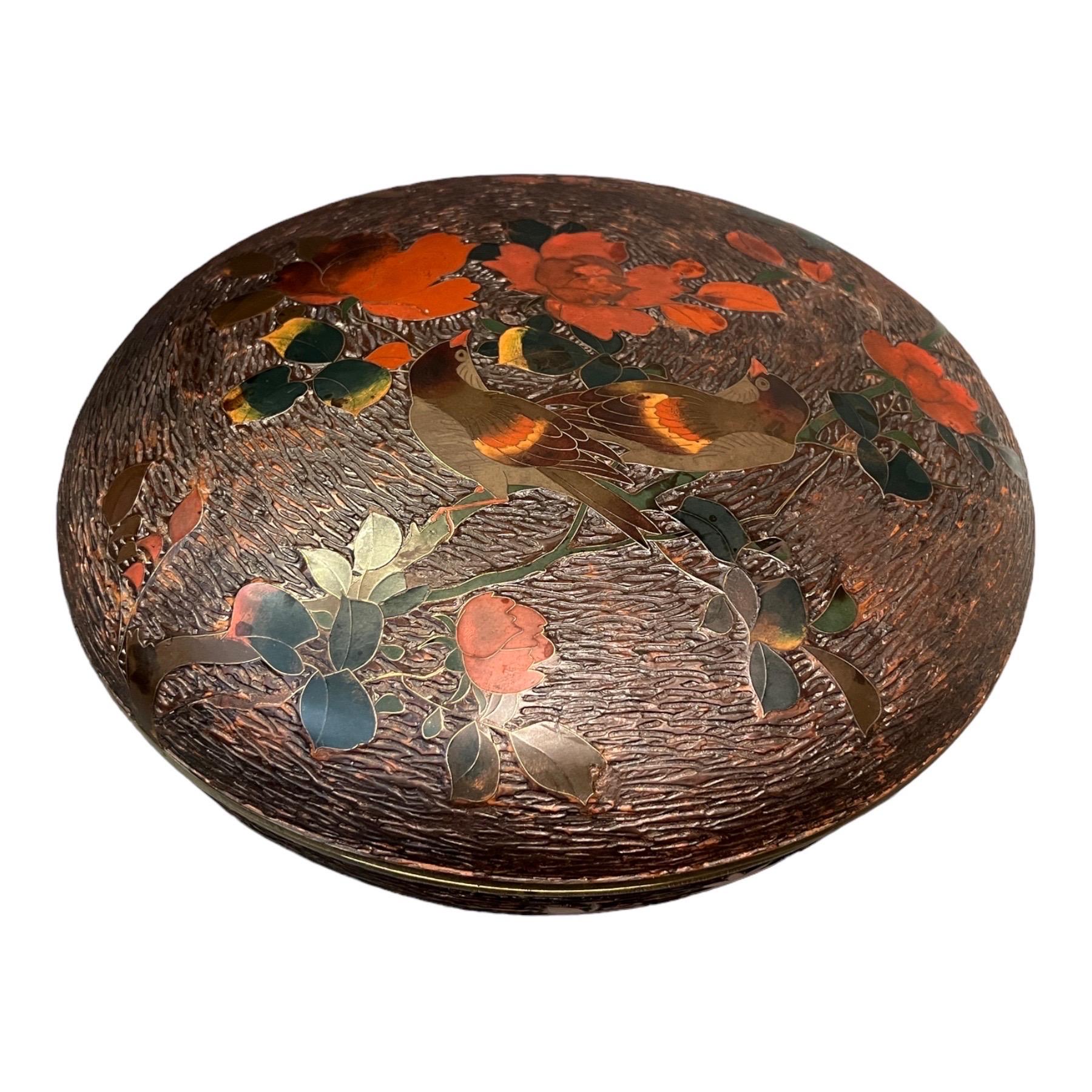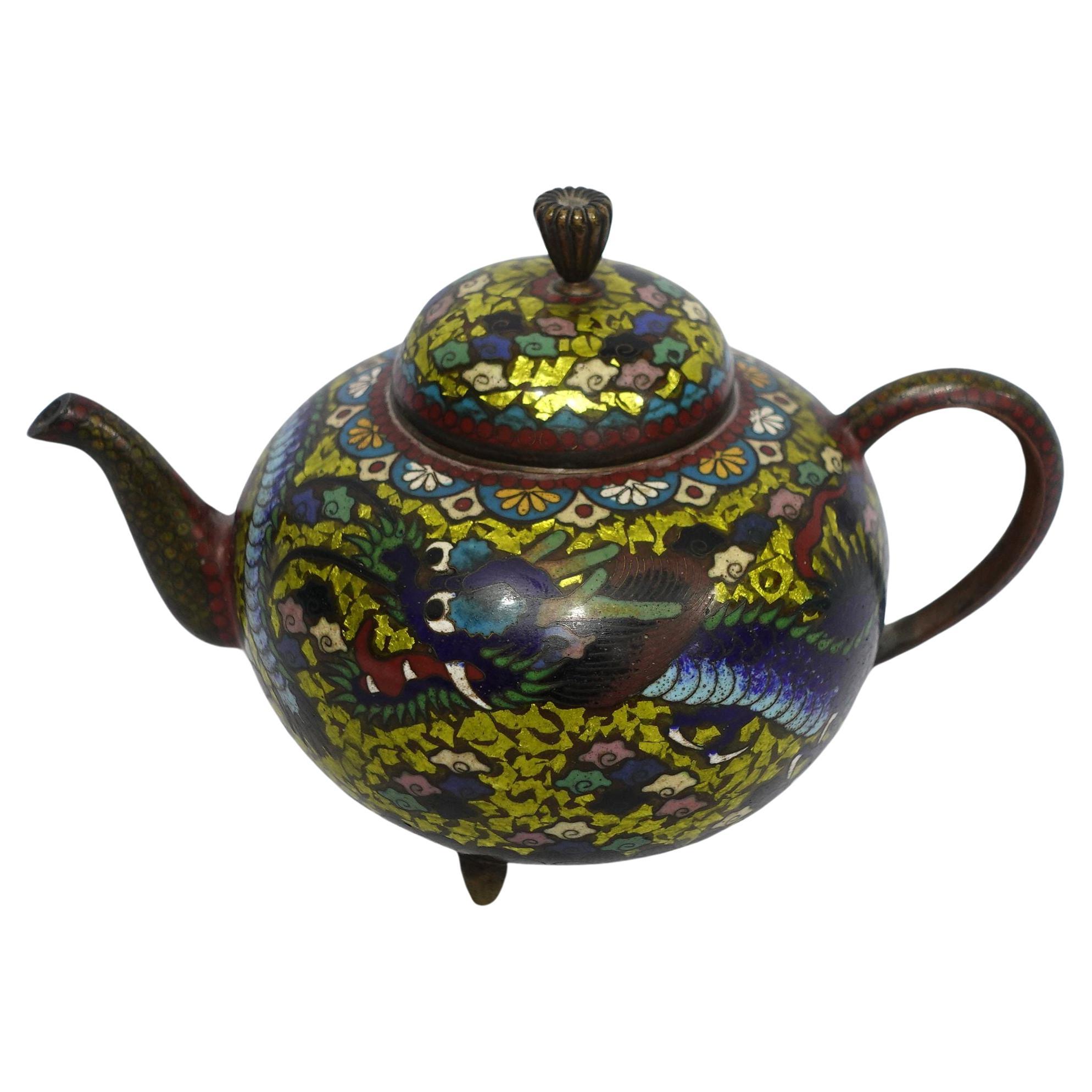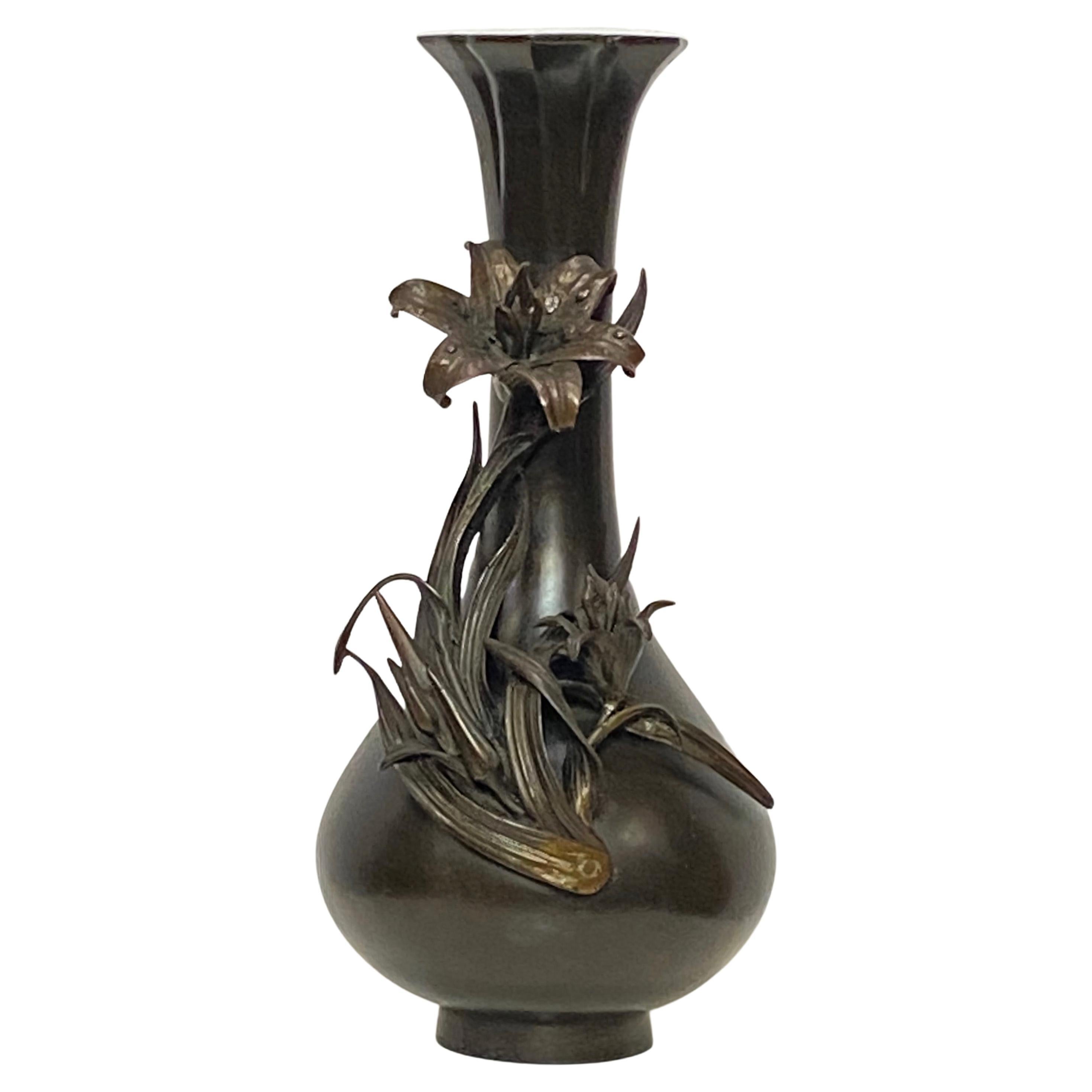Items Similar to Amazing Japanese silver teapot and cover, dragon spout Meiji period 19TH century
Want more images or videos?
Request additional images or videos from the seller
1 of 13
Amazing Japanese silver teapot and cover, dragon spout Meiji period 19TH century
About the Item
amazing rare archaistic style silver ewer or tea pot with cover, the design is Of archaistic style dragons on the main frieze and on the cover, this style came from ancient Chinese art, the spout is designed as the head of a dragon or a mythical beast with big ears And hair. the handle is attached to this pair of amazingly realistic shishi lions masks.
This tea pot is made from sterling silver and on the inside there are two solid silver pieces Attached to the bottom and i think they are there for keeping the tea hot.
The tea pot is not marked with any Japanese marks but it is attributed to the work of : "HATA ZOROKU" 1823-1890 that was working in the late 19th century.
There are two import marks, one is small and illegible and the second is a crowned V That was used in the Netherland between 1814-1893, so this fits the date window of Hata Zoroku and the other great masters of the Meiji period.
Another similar ewer and not a tea pot by Hata Zoroku was just sold at CHRISTIES auction house, on the 22/3/2022 , it was sold for 15,120 $ (a print screen in the last picture)
Size :
Height with handle : 17.5 cm / 6.9 inch
Height without handle :14 cm / 5.5 inch
Width from one side to the tip of the spout : 17 cm / 6.7 inch
Weight is 470 Grams
- Dimensions:Height: 6.7 in (17.02 cm)Diameter: 6.9 in (17.53 cm)
- Materials and Techniques:
- Place of Origin:
- Period:
- Date of Manufacture:1890
- Condition:Wear consistent with age and use. condition is very good, no brakes or repairs, some minor dents and scratches and age worn to the silver, this item was not repaired in any form,.
- Seller Location:Tel Aviv - Jaffa, IL
- Reference Number:1stDibs: LU8130238131922
About the Seller
No Reviews Yet
Vetted Seller
These experienced sellers undergo a comprehensive evaluation by our team of in-house experts.
1stDibs seller since 2023
- ShippingRetrieving quote...Ships From: Tel Aviv - Jaffa, Israel
- Return PolicyThis item cannot be returned.
More From This SellerView All
- Antique early 20th Chinese Exceptional Solid Silver Teapot, Wu Hua物華, TianjinLocated in Tel Aviv - Jaffa, ILAntique early 20th Century exceptionally rare Chinese solid silver teapot, of traditional round form, the body finely engraved in traditional Chinese style, suggesting this teapot was made for the Chinese market. The body engraved with bamboo and butterflies , the unusual handle imitating bamboo, the removable lid set with a peach finial (Peaches are the symbol of longevity). According to Daoist lore, the peaches of immortality grew in the garden of the Queen Mother of the West - Xi Wangmu. the spout with a hedged cover in the shape of a lingzhi mushroom and a FU symbol of good furtune. the top frieze is decorated with 8 Chinese symbols: a scroll, a Ruyi scepter, a qin, The Endless Knot, a pendant, an old book, a wrist rest, and two overlapping squares. The teapot is very unusual, fine and exceptionally crisp. it is made of heavy Gauge silver and the attention to detail and design is simply outstanding. "WU HUA...Category
Early 20th Century Chinese Chinese Export Metalwork
MaterialsSilver
- Satsuma earthenware vase by kinkozan, Meiji periodBy KinkozanLocated in Tel Aviv - Jaffa, ILthe body of this small marvelous vase is painted with a scene of a puppet show vendor with his wood backpack, on top of the backpack there are toys and dolls, he is surrounded with a group of 6 children, and on the background you can see a village. on the other side of the vase there is an amazing painting of flowers and on the sides there are two amazing strong pine trees, the amorphous background is decorated in a "Tortoiseshell" color and design that gives it a real character and which is quite rare to see on satsuma pottery. all the vase is over richly overpainted over the glaze with gold, which gives it its depth and realism. signed Kyoto Kinkozan zo, and sealed Kinkozan zo Kyoto’s Satsuma: The painting technique used in Kyoto’s Satsuma-style ware is said to be the invention of the sixth generation Kinkōzan Sōbei (1824–1884). The Kinkōzan were a famous family of Kyoto Awataguchi potters who made ceramics that were used at Shōren'in, a temple closely tied to the imperial family, and by the shoguns of the Edo government. In fact the shogun is said to have granted them the name Kinkōzan. With the upheavals at the end of the Edo period, however, and the reforms of the subsequent Meiji government, the potters lost their traditional patrons and had to develop new markets. Just at that time, the visit of a certain Westerner is said to have decided them to embark on overseas trade. By 1870, they had perfected Kyō Satsuma...Category
Antique 1890s Japanese Meiji Ceramics
MaterialsGold
- extremely rare Algerian Judaica silver, jewish Dowry box early 19th centuryLocated in Tel Aviv - Jaffa, ILAmazing and scarce JUDAICA object, we have here one of the most touching jewish objects we had for a long time, this small silver dowry box was made in Algeria in the early 19th century, it is all covered with symbols of jewish faith and of couples, the sliding lid has 2 flanking birds with hamsa (protective hand) on each side and a flower vase in the middle. one side shows two flanking lions with a tree in the middle and the other side shows again two big and two small birds with a flower bowl in the middle, front side has a key hole and next to it there is the Hebrew inscription ס״ט״" which says Siman tov or in English "a good sign" it is taken from the wedding blessing, underneath the lock there is another inscription with the name ״עזיזה בת אברהם בן חמו״ which is the name of the bride, her father and her grandfathers name. the box is full marked a lot of times with the silversmith mark, every side of the box is marked. this box was probably ordered by the grooms family to hold the jewelry they are giving to the bride as dowry, this type of objects are rare and there are just a few of them on museum collections. DOWRY (Heb. נְדֻנְיָה), the property a wife brings to her husband at marriage; the Yiddish equivalent, nadn, is from the same root. The custom of nedunyah became clearly defined and institutionalized only in the talmudic period. In biblical times, mohar (מֹהַר), whereby the groom bought his wife from her father (Gen. 24:53; Ex. 22:15–16; Hos. 3:2), was the accepted practice. It was then customary that the groom give the bride gifts, and that she bring certain property to her husband's home upon marriage: slaves, cattle, real estate, etc. (cf. Gen. 24:59–61; 29; Judg. 1:14ff.; I Kings 9:16). Evidence of the custom of nedunyah is to be found in Tobit (7:14; 8:21) and in the Assuan papyri (Cowley, Aramaic, nos. 15, 18). Gradually, mohar was superseded by the ketubbah custom according to which the husband merely assumed the responsibility of compensation to his wife in case he divorced her: he had to pay her 200 zuzim if she had been a virgin at the time of marriage, and 100 zuzim if a widow or divorcée (see *Ketubbah). By talmudic times, the institution of nedunyah was prevalent; the father gave a dowry to the bride since the daughter was excluded from paternal inheritance. Fifty zuzim (equivalent to the worth of 180 grams of silver) was the minimum amount a father was obliged to give to his daughter (Ket. 6:5). Parents usually gave much more, according to their social standing. Community funds provided the dowry for an orphan or a very poor girl (ibid.; cf. Sh. Ar., YD 251:8). In case of her father's death, the brothers of a minor girl were obliged to give her the minimum dowry, and the court estimated how much her father would have given her above the minimum dowry. The sum was then taken out of the father's estate and given to the daughter upon majority (Ket. 6:6; 68a–69b). In the absence of such an estimate, each daughter was entitled to receive one-tenth of the value of her father's estate in money, or in valuables (Yad, Ishut, 20:4–7; Sh. Ar., EH 113:4). If the father was unable or unwilling to pay the promised dowry at the betrothal ceremony, the groom could refuse to marry his bride (Ket. 13:5; Ket. 108b–109a). Insistence on exact payment of the promised dowry, however, was frowned upon by later rabbinic authorities (Rema to Sh. Ar., EH 2:1). In certain communities it was customary for the groom's father to make a dowry contribution equal to that of the bride's father (Ket. 102b). The dowry, whether given in real estate, slaves, money, or chattel was recorded in the marriage contract (the ketubbah) and in some instances one-third or one-fifth of the actual value of the dowry was added to the sum mentioned in the ketubbah. Based upon a decree enacted by *Simeon b. Shetah (first century C.E.), the Talmud ruled that the husband and his entire property were liable for compensation as stipulated in the ketubbah, either in case he died (when she collected the sum specified in the ketubbah from the heirs) or in case he divorced his wife (Ket. 82b). For the status of the dowry and the husband's rights and obligations, see below. The rabbinic enactments (Takkanot Shum) by R. Jacob *Tam and by the rabbinic synod of the communities of Speyer, Worms, and Mainz (Germany) stipulated that if a woman died...Category
Antique Mid-19th Century Algerian Tribal Art
MaterialsSilver
- French faience Passover plate, JUDAICA 19th centuryLocated in Tel Aviv - Jaffa, ILthis plate has a creme white background, the center painted with a man holding a lamb before a cityscape, probably a depiction of Jerusalem by someone who never actually visited the city or even see it, under the man there is the word Passover "פסח" the rim with the order of the Seder, and some grape vines between them. Passover, also called Pesach ( Biblical Hebrew: חַג הַפֶּסַח, romanized: Ḥag haPesaḥ), is a major Jewish holiday, one of the three pilgrimage festivals, that celebrates the Biblical story of the Israelites' escape from slavery in Egypt. Pesach starts on the 15th day of the Hebrew month of Nisan which is considered the first month of the Hebrew year. The Hebrew calendar...Category
Antique Late 19th Century French Victorian Platters and Serveware
MaterialsPottery
- Rare "Safed" kiddush cup, late 19th century Poland/ Eretz ISRAELLocated in Tel Aviv - Jaffa, ILThis 84 silver cup was made in Europe, in Poland or parts of Poland that are in modern Russia in the 19th century, the interesting and important in this cup types is that they were s...Category
Antique 1890s Israeli Sterling Silver
MaterialsSilver
- Important Early 20th Century Silver Kiddush Goblet by Bezalel School JerusalemLocated in Tel Aviv - Jaffa, ILImportant Handmade sterling silver Kiddush goblet by Bezalel School, Jerusalem, circa 1910-1913. On round base decorated with silver filigree and Cabouchon shaped green agate applications. The base fitted with Bezalel mark. The upper portion is all adorned with amazing filigree work, the base and the actual cup adorned with swirling filigree designs, in the middle there are 3 roundels, made in another technique of hammered silver, similar to the works that were produced in this time all over Europe, in the middle of each roundel there is a perfectly centered Cabouchon green agate. This work is attributed to Yehia Yemini. The goblet is marked on the base, with the earliest silver mark of the school that just say "Bezalel" in Hebrew. Yehia Yemini : Was one of the biggest and must famous Bezalel silver...Category
Early 20th Century Israeli Jugendstil Sterling Silver
MaterialsSilver
You May Also Like
- Large Japanese Cloisonné Box and Cover, Japan, Meiji Period, 19th CenturyLocated in PARIS, FRA rare Japanese bark tree large cloisonné box on metal from the Meiji period. Usually bark tree cloisonné was on porcelain (totai Shippo) A very attracti...Category
Antique Late 19th Century Japanese Metalwork
MaterialsMetal
- Antique Japanese Cloisonné Meiji Period Dragon Teapot CO#06Located in Norton, MAQuality work, amazing workmanship with absolutely fine details bronze cloisonné enameled teapot depicting the scene of a flying dragon with vivid colors of yellow, light golden green...Category
Antique 19th Century Chinese Metalwork
MaterialsBronze, Copper
- Antique Japanese Cloisonné Meiji Period Dragon Footed Teapot CO#04Located in Norton, MAQuality work, amazing workmanship with absolutely fine details bronze cloisonné enameled teapot depicting the scene of a flying dragon with vivid colors of yellow, light golden green...Category
Antique 19th Century Chinese Metalwork
MaterialsCopper, Bronze
- Japanese Cloisonne Box, Meiji Period, Late 19th Century, JapanLocated in Austin, TXA very fine and intricately decorated Japanese cloisonné box and cover, Meiji period, late 19th century, Japan. The lidded trinket or jewelry...Category
Antique 1890s Japanese Meiji Metalwork
MaterialsBrass, Copper, Enamel
- Large 19th Century Japanese Meiji Period Bronze VaseLocated in San Francisco, CAA large and elegant Meiji period bronze vase with floral decoration and original patina, unsigned. Japan, last quarter of the 19th century.Category
Antique Late 19th Century Japanese Meiji Metalwork
MaterialsBronze
- 19th Century Large Japanese Meiji Period Bronze VaseLocated in New York, NYLarge antique (19th century) Japanese patinated bronze centerpiece vase with fine reliefs depicting cranes in flight above the sea with waves and temple gate representing the Itsuku...Category
Antique Late 19th Century Japanese Meiji Metalwork
MaterialsBronze
Recently Viewed
View AllMore Ways To Browse
Sterling China Japan
Antique Chinese Window Screen
Meiji Period Japanese Bronze Bird
Meiji Era Bronze
Asian Ceremonial Dagger
Japanese Cloisonne Incense Burner
Large Outdoor Incense Burner
Etched Indian Pot
Tibet Dagger
Two Large Khmer Foo Dogs
English Cast Iron Saddle Racks
Meiji Bronze Wave
Tall Incense Burner
Antique Asian Cloisonne Eggs
Antique Tsuba
China Brazier
Chinese Brazier
Large Persian Brass Tray





